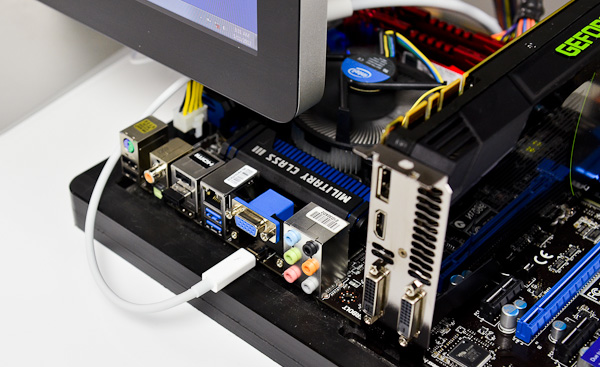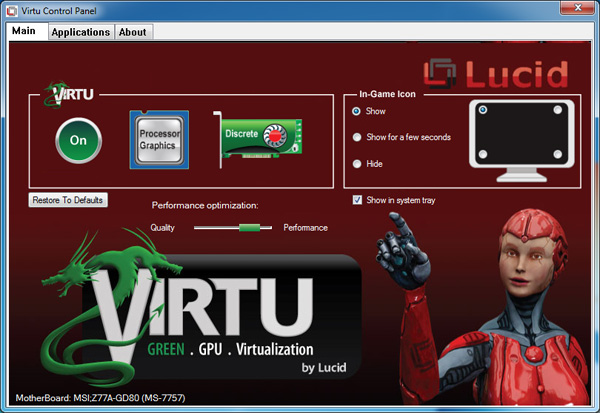A First Look at Thunderbolt on Windows with MSI's Z77A-GD80
by Anand Lal Shimpi on May 11, 2012 1:32 PM EST- Posted in
- Motherboards
- CPUs
- Intel
- MSI
- Thunderbolt
The Thunderbolt Display
The first test was hooking up Apple's Thunderbolt Display, the only Thunderbolt display device available on the market today. Although I shouldn't have been, I was a bit surprised when the display just worked. Intel's HD 4000 drove the 2560 x 1440 panel just fine and there weren't any funny issues displaying the lower res UEFI setup mode.
Despite Ivy Bridge being able to drive three independent displays, I was only able to simultaneously output to two connected displays on the GD80. All combinations of two worked however (TB + HDMI, TB + VGA, VGA + HDMI).
Once in Windows, the Thunderbolt Display's integrated GigE, Firewire and other controllers started popping up. Unfortunately Apple doesn't offer a direct download package for Thunderbolt Display drivers. You can either hunt down the controllers/drivers on their own, or you can build a Windows Support (driver) package using a Mac and the Boot Camp Assistant. I'd much rather Apple just offer an easy route for non-Mac Windows users to take advantage of the Thunderbolt Display as it's the only TB display on the market, but I can understand the lack of motivation there.
With the Boot Camp drivers installed, I got working GigE and Firewire 800. The Thunderbolt Display's integrated USB hub gave me issues however. Anything I plugged into it would either partially work (e.g. my mouse was detected but moving the cursor was far from smooth) or not work at all (e.g. my attached USB keyboard never worked). The other issue with the Thunderbolt Display is you get no brightness control, which can be a problem given how bright the panel gets. I've seen reports of people getting brightness control working via software tools but the solutions don't seem permanent.
Apple's Thunderbolt Display definitely works, but Windows users will likely want to wait for a Thunderbolt display that is built specifically with Windows in mind.
Virtu and Thunderbolt: It Works
From a software perspective, Thunderbolt is treated just like another display output driven by Intel's processor graphics. I installed a GeForce GTX 680 along with Lucid's Virtu GPU virtualization software to see if I could use the 680 for gaming but drive the display using Intel's processor graphics and the Thunderbolt port. The setup worked flawlessly.
Virtu recognized the configuration immediately once I had NVIDIA's drivers installed, and I was able to run the 680 headless - using only the Thunderbolt port to drive the external display. Intel's HD 4000 powered things in Windows, while the 680 kicked in for games.













98 Comments
View All Comments
ananduser - Friday, May 11, 2012 - link
I recall MS stating that TB will never be supported by them due to security issues. TB support will have to be provided by 3rd parties.A5 - Friday, May 11, 2012 - link
And the article pretty clearly states that TB is transparent to the OS because it is just a bunch of PCIe lanes. MS doesn't really need to do anything to enhance support.embeddedbill - Friday, May 11, 2012 - link
The security issues have nothing to do with 3rd party support. Pcie in every other instance was an internal device, now via TB, someone can develop a piece of hardware that has nefarious firmware and gain system level access - without opening up the computer.DerPuppy - Saturday, May 12, 2012 - link
pretty much: see firewire. direct memory access "issues" i guess. but if someone has physical access to your computer you're screwed anyways.ka_ - Friday, June 1, 2012 - link
"pretty much: see firewire. direct memory access "issues" i guess. but if someone has physical access to your computer you're screwed anyways. "I must say I disagree to this to a large extent even though I would agree if we add: Physical access without anyone else present.
It is something entirely different to require someone to force power offs, use screw drivers, or do some other highly unusual things to a machine than simply plug it to a display or NAS or something with two tb connectors and hack it from the machine connected on the other side. That or a device with chained TB connectors i.e. projector sharing the connection with a Trojan device.
Expect to see something like this on a security conference soon... "We tested this projector on all the presenters machines and..."
embeddedbill - Friday, May 11, 2012 - link
Microsoft will also have an aversion to anything that allows you to boot using Windows on an external disk. Pcie is a threat to that because they might feel some loss of control.dagamer34 - Saturday, May 12, 2012 - link
Em... Windows 8 To Go allows you to boot a full version of Windows from a USB stick.Conficio - Friday, May 11, 2012 - link
And why again would I pay top dollars (for the mother board, the peripheral and the cables to connect those) to put the storage outside of my full size desktop? I don't see the use case.If it would be a nice small form factor running silently and still is expandable through thunderbolt, that would make sense.
Or if I can access the storage and the display in my desktop through thunderbold from my laptop (and auto backup/sync/drop box) that would make sense as well. The standby desktop becoming the hub, sounds feasible to me as the interface is symmetrical.
By the way w/o hot plugging this is broken. As you report those issue on Mac OS X as well, I'll go and wait until this becomes stable.
embeddedbill - Friday, May 11, 2012 - link
The most compelling use cases will be in the mobile market for sure. However for someone who covets the bandwidth for frivolous stuff, I can see this in a niche.ggathagan - Friday, May 11, 2012 - link
Given the ability to daisy chain up to six devices, this could represent an awful lot of storage capacity.From the manufacturer's standpoint, I think it makes a lot of sense for MSI to use ATX for their 1st motherboard with TB.
ATX has lot more real estate to work with when deciding how to design the motherboard.
It's also their flagship Z77 motherboard, with all the bells-and-whistles.
At the price point of their flagship board, it helps recoup R&D costs.
Given the scarcity of TB devices at this point in time, I doubt anyone wants to dive in.
I expect more of a "sticking-my-toes-in-the-water approach from board makers.
Once there are more devices made to utilize TB, I think you'll see a more widespread adoption of TB.
As others have pointed out, TB has a better fit in the mobile market at this point.